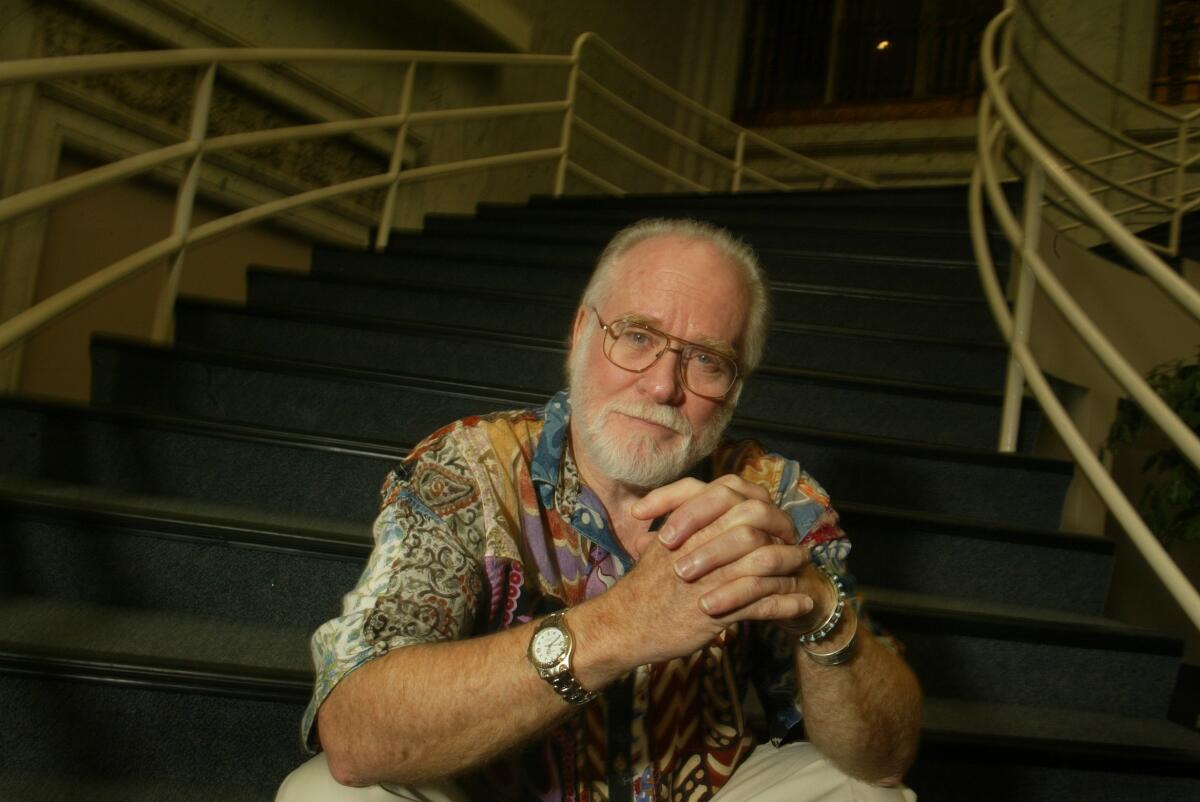Visionary L.A. theater impresario Bill Bushnell dies at 86

- Share via
Former theater impresario Bill Bushnell, who led the influential but short-lived Los Angeles Theatre Center during a heady six-year run in the late 1980s, has died at age 86.
One of the key figures in the city’s theater scene in that era, Bushnell died Jan. 31 in Cueca, Ecuador, where he had retired, according to former colleague Lisa Mount. No cause was given.
Bushnell was the driving force behind the creation of the city-run Los Angeles Theatre Center, a four-stage complex in a renovated bank building on Spring Street, and he oversaw the theater’s programming from 1985 to 1991.
While the venture lasted only a handful of years before collapsing under the weight of debt, it served for a time as a beacon for the local theater community, rivaling the nearby Center Theatre Group as the heart of the city’s nonprofit professional theater scene and inspiring future generations with its multicultural programming.
Gordon Davidson, the Center Theatre Group impresario who launched, defined and for 38 years personified Los Angeles’ flagship theater, the Mark Taper Forum, has died, his family said.
William H. Bushnell Jr. was born April 30, 1937, in Detroit. He graduated from Denison University in Granville, Ohio, studied theater directing at the University of Kansas and earned a master of arts in theater history and management from Ohio State University. After stints at Baltimore Center Stage and San Francisco’s American Conservatory Theatre, Bushnell moved to Los Angeles and supplemented his theater work, directing the films “The Four Deuces” and “Prisoners,” and an episode of the TV show “The Waltons.”
In early 1978, Bushnell and “Waltons” star Ralph Waite were filming “On the Nickel,” a movie written and directed by Waite about life on Skid Row. They had offices downtown at the Alexandria Hotel on Spring Street.
“Across the street I would see a building, a Greco-Roman structure that was falling to ruin, covered with graffiti and, usually, sleeping or dead bodies,” Bushnell told peers at a convention of arts leaders in 1984. “I used to look at that building, and that part of me that is an urban animal used to say, ‘Why doesn’t somebody do something?’ ”
In late 1978, Bushnell — known as “Bush” to friends and colleagues — took over the reins of LATC’s predecessor, the Los Angeles Actors’ Theatre, from founder Waite. Then housed in two modest theaters on Oxford Avenue off Santa Monica Boulevard, the Los Angeles Actors’ Theatre received a grant to build a new complex in Hollywood but the deal fell through. Bushnell turned to the city’s Community Redevelopment Agency, which had a desire to revitalize the eastern side of downtown along Spring Street. Fortune intervened and the agency showed him the 1916 Security Bank building — the very structure he originally had his eye on. But the road from Hollywood to downtown would prove to be full of twists and turns.
“Twice in the next 4½ years, I walked away from the project throwing my hands in the air,” Bushnell told The Times in 1985. “I learned in certain life programs I practice that you can only beat your head against the brick wall so long before you get so bloody you cannot see.”
As a “reforming alcoholic living one day at a time,” Bushnell lived by the theory that “if you don’t keep moving forward, you stop.”
Finally, in 1982, a complex deal was put into place and the paper work filed on New Year’s Eve to beat the deadline on the expiration of an IRS regulation giving real-estate tax credits to private investors putting up bonds to help build places of entertainment. Two-and-a-half years later, Bushnell’s dream would become a reality with the opening of the newly rechristened Los Angeles Theatre Center.
Under Bushnell’s leadership, the theater produced up to 18 shows a year along with a new-play festival, poetry readings, dance performances and a quarterly journal. “The Theater of the Brash Makes It Big,” The Times wrote in a headline in 1985. Bushnell built LATC’s audience to more than 25,000 subscribers at its peak.
With Bushnell at the helm, the theater placed an emphasis on developing new work from playwrights of color and marginalized communities. That legacy has continued with the Latino Theater Company, which was created as a lab under Bushnell and the LATC. Led by Artistic Director José Luis Valenzuela and Associate Artistic Director Evelina Fernandez, it reopened the LATC in 2007 and has produced more than 150 plays.
Speaking with Lisa Mount for a recent tribute to Bushnell in American Theatre magazine, Valenzuela said: “We only exist because of him. Bush was a visionary who believed in diversity in the 1980s; it was where he thought the country was going.... He gave so many opportunities to eager young people, creators who were hungry to speak with their own voices.”
Following the collapse of LATC in 1991, Bushnell worked for more than a year at Cal State Long Beach and its theater wing, CalRep. The job ended due to financial cuts by the state.
Soon after, Bushnell left the city, writing in a holiday letter to friends and acquaintances that L.A. had become “creatively toxic.” For a time, he lived on a boat in the Virgin Islands, and he later worked as a disaster relief employee with the Federal Emergency Management Agency.
While doing public relations work for FEMA in the aftermath of disasters, he met Leita Hulmes, a geologist. The couple married and retired together in Ecuador.
“I had perfect training for working on disasters — 35 years in the theater,” Bushnell quipped to The Times in 2003.
More to Read
The biggest entertainment stories
Get our big stories about Hollywood, film, television, music, arts, culture and more right in your inbox as soon as they publish.
You may occasionally receive promotional content from the Los Angeles Times.












